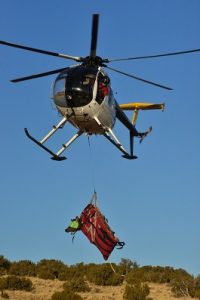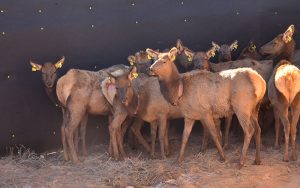- Slug: BC-CNS-Elk Project. About 420 words.
- Video here.
- Photos and captions below.
By ABDEL JIMENEZ
Cronkite News
FLAGSTAFF – Five dozen Arizona elk recently traveled more than 2,000 miles to West Virginia in an effort to restore the population in a state that hasn’t seen elk since the Civil War.
The elk now roam the Tomblin Wildlife Management Area. Officials said they hope the reintroduction will contribute to the state’s tourism industry, mostly through hunting.
The Arizona Game & Fish Department partnered with the West Virginia Division of Natural Resources to capture 60 elk in late January. Wildlife managers and volunteers used helicopters, trucks and net-loaded guns to collect the animals, which were shipped east in livestock trailers.
“We knew that Arizona had a disease-free herd – a healthy herd. They did not have chronic wasting disease, which is a big concern,” said Randy Kelly, the West Virginia project leader.
Arizona is one of just two states whose elk population is robust and healthy, said Steve Clark, executive director of Arizona Elk Society. Chronic wasting disease is a highly contagious neurological disease in elk, moose and some deer.
Elk were native to West Virginia, the Mountaineer State, but have not been seen there in 150 years.
“In the 1800s, there was a lot of overharvesting and unregulated removal of animals,” said Shelly Shepherd, the information and educational program manager for the Arizona Game & Fish Department.
West Virginia officials hope to establish a population of 2,800 elk through the restoration project.
“West Virginia is excited to have elk,” Shepherd said. “That’s a state that hasn’t had elk in a long, long time.”
She lives in the Raymond Wildlife Area, a 45-minute drive from Flagstaff, where Arizona Game & Fish quarantined the animals for about a month.
The Rocky Mountain Elk Foundation and West Virginia Division of Natural Resources paid for the project, Shepherd said. They used wildlife restoration funds – money collected through the purchase of hunting and fishing licenses and other outdoor equipment by sportsmen.
This marks the second time Arizona has helped another state restore its elk population. In 2000, the state sent 26 animals to Kentucky, Game & Fish officials said.
In 1913, Arizona received elk from Yellowstone National Park to re-establish its own population, which has grown to 45,000 animals today.
Asked how he feels about reintroducing a major species to his state, Kelly said: “There is a little bit of redneck mountaineer pride involved as well.”
This story is part of Elemental: Covering Sustainability, a new multimedia collaboration between Cronkite News, Arizona PBS, KJZZ, KPCC, Rocky Mountain PBS and PBS SoCal.
[su_divider top=”no” size=”1″ margin=”10″]
[sub-tag]
For more stories from Cronkite News, visit cronkitenews.azpbs.org.
^_=

